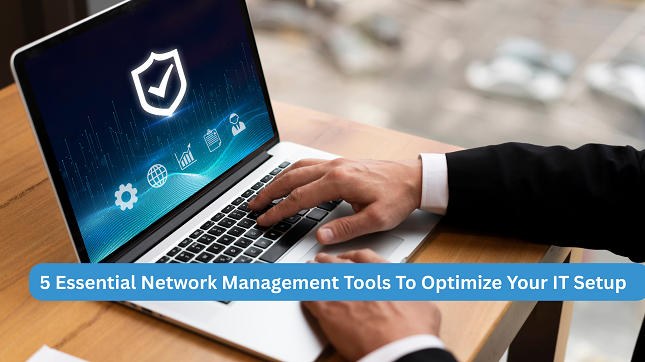Your business depends on a strong and reliable network. When your network is slow or keeps breaking down, your work suffers. Customers may not get the service they need, and your team may struggle to stay productive. That is why network management is so important.
But wait—what does network management really mean?
In simple terms, it means using tools to keep your network running smoothly. These tools help you find problems, fix them quickly, and even prevent future issues.
Let’s look at five essential network management tools that can optimize your IT setup. Each one plays a unique role in making your systems faster, safer, and easier to manage. Let’s explore them together.
1) Network Monitoring Tools
The first step in taking care of your network is to know what’s going on inside it. That’s where technologies for monitoring networks come in. These tools let you see how well your network is working. They tell you what devices are linked, how much traffic is going through them, and whether there are any strange surges.
Moreover, these monitoring tools discover the cause of a problem, like when your system slows down. It could be broken equipment, too much traffic, or even a security risk. You can take action before tiny problems turn into big ones with real-time warnings.
Many people use well-known monitoring software, and you don’t need to be a tech expert to put them up and read the reports they send you.
You can save time and money by using monitoring tools. You get updates before users complain. This way, your IT team can stay ahead of the game and keep everyone functioning without problems. Monitoring tools should be at the top of your list to keep your network healthy.
However, if you are not sure which network monitoring tool to use, you can opt to hire network management services. These services offer you complete network monitoring and management solutions to help your business maintain productivity and minimize potential issues.
2) Configuration Management Tools
It might be challenging to keep track of all the devices and settings as your network expands. That’s where configuration management tools help. These programs keep track of all the settings for your routers, switches, firewalls, and other network equipment.
Why is this essential? Think about how one little change in a device setting could make your entire system stop working. It can take hours to figure out what went wrong without configuration management. However, with the right tool, you can easily go back to the last functional version.
Ansible, Puppet, and RANCID are all fantastic tools for automating configuration jobs. You can make adjustments to more than one device at a time with them, which reduces errors. You save time by using one central platform instead of manually logging into each device.
These tools also track all the changes made to the setup. This makes it easier to see who made changes and when. It’s not only about convenience for businesses; it’s also about safety and following the rules.
You get stability, safety, and speed with configuration management solutions. They ensure that your IT setup is consistent and reliable, which means less stress for your team.
3) Network Security Tools
One of the significant worries in IT right now is security. Cyberattacks, viruses, and illegal access are always a threat to networks. You need powerful network security tools for this reason. These technologies keep your data, devices, and users safe from threats that could crash your system.
Firewalls, intrusion detection systems (IDS), and intrusion prevention systems (IPS) are some of the most common ones. They look at traffic and stop any suspicious activity before it can do any harm. Antivirus software and endpoint security technologies are also crucial for keeping users safe.
Advanced security technologies update you on potential attacks in real time and help you react swiftly when something strange happens. Many of these solutions also come with automated updates, which means you’re always safe from the newest attacks.
4) Performance Optimization Tools
Even if your network is safe and under surveillance, it can still slow down. That’s when performance optimization tools come in to help. These utilities help your system run as fast and efficiently as possible.
They can, for instance, spread the work evenly among servers so that one system doesn’t get too busy. Furthermore, they also make sure that key apps always operate smoothly by managing bandwidth. Performance tools can give business apps more priority if too many people are watching movies.
Moreover, they show you how traffic flows, how well applications work, and how resources are used. Your IT team can use this information to make sensible changes that will improve performance and reliability.
5) Troubleshooting and Diagnostic Tools
No matter how well you monitor and optimize, things will still go wrong. So, you need troubleshooting and diagnostic tools to locate the core problem. These technologies enable IT workers to test connections, find problems, and fix them quickly.
For instance, a simple tool like ping tests whether a device is reachable. Wireshark and other more powerful programs can capture and analyze data packets to uncover problems that aren’t obvious. You can find bottlenecks, packet loss, or misconfigurations with these tools.
One significant plus is how quick it is. You don’t have to guess; you can use precise data to figure things out. This implies your business will have less downtime and your staff will be happier.
Conclusion
Every modern business needs a strong network to work. However, you need the correct tools to keep it healthy. Each tool has an important job, from monitoring and managing configurations to security, optimization, and fixing problems.
These five crucial network management tools not only cure problems, but they also help stop them from happening in the first place. They protect your systems and keep them running quickly and safely.






































